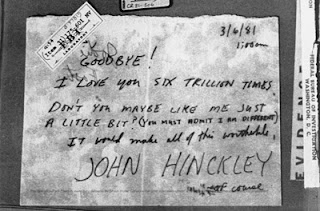John Hinckley, Jr.shoots President Ronald Reagan outside the Hilton Hotel in Washington D.C. just after the president had addressed the Building and Construction Workers Union of the AFL-CIO. Hinckley was armed with a .22 revolver with exploding bullets and was only ten feet away from Reagan when he began shooting. Fortunately, he was a poor shot and most of the bullets did not explode as they were supposed to. Hinckley’s first shot hit press secretary James Brady and other shots wounded a police officer and a Secret Service agent. The final shot hit Reagan’s limo and then ricocheted into the President’s chest.
Hinckley’s path toward the assassination attempt began in 1976 when he saw the movie Taxi Driver. Robert DeNiro’s Travis Bickle stalks a Presidential candidate in the hopes that he will somehow impress and rescue a young prostitute played by Jodie Foster. Hinckley, who spent seven years in college without earning a degree or making a friend, added Foster to his list of obsessions, which also included Nazis, the Beatles and assassins.
In May 1980, Hinckley wrote to Foster while she attended Yale University, traveled there and talked to her on the phone at least once. Soon after, he began following President Jimmy Carter. In October, he was arrested at airport near a Carter campaign stop for carrying guns. However, the Secret Service was not notified. Hinckley simply went to a pawnshop in Dallas and bought more guns.
For the next several months, Hinckley’s plans changed daily. He pondered kidnapping Foster, considered killing Senator Edward Kennedy and began stalking newly elected President Reagan. Finally, he wrote a letter to Foster explaining that his attempt on Reagan’s life was for her. He kept abreast of the president’s schedule by reading the newspaper.
After Reagan was shot and nearly killed, there was a great deal of confusion at the upper levels of government. In the most notable incident, Secretary of State Alexander Haig told the press that “I am in control here in the White House, pending return of the vice-president,” under the mistaken belief that the chain of command placed him in charge.
Hinckley was later not found not guilty by reason of insanity.
Article Details:
March 30, 1981 : Ronald Reagan is shot by John Hinckley, Jr.
Author
History.com StaffWebsite Name
History.comYear Published
2009Title
March 30, 1981 : Ronald Reagan is shot by John Hinckley, Jr.URL
http://www.history.com/this-day-in-history/ronald-reagan-is-shot-by-john-hinckley-jrAccess Date
March 30, 2016Publisher
A+E Networks
























































